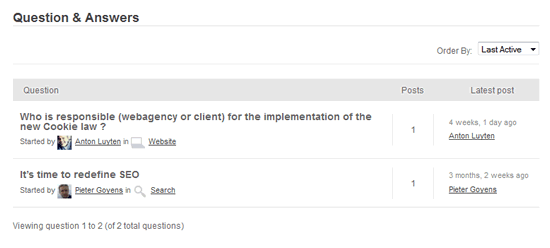
Online communities existed before we even heard about blogs. Since social technologies and platforms popped up, the number of possibilities to facilitate, nurture and engage online communities has exploded.
Strangely enough, communities are not given the attention they deserve by businesses. Most of the time, you will find community engagement and management ideas when looking for information on the topic. However, online communities are about much more than that. While we mainly talk about conversations and engagement in social media, community is the true force in a connected era.
What can online communities do? Everything.
In their book ‘Communities Dominate Brands’, Tomi Ahonen and Alan Moore, wrote “Communities are the counterbalance to brand dominance in the twenty-first century… furthermore, we establish that by harnessing community power and working with them, a modern marketer can succeed in delivering remarkably positive marketing effects to the intended target audience“.
Online communities can serve ALL marketing and lots of business goals. From enhancing customer retention and crowdsourcing to market research, customer service and branding: communities offer the answer. Setting the proper goals, identifying the community ‘audience’, gauging needs, planning, measuring, managing and engaging are essential tasks before launching a community.
So, what can communities do? Everything really. However, reverse the question to succeed: what can you do for a community?
Key challenges and mistakes regarding online communities
There are several reasons why online communities get less attention than social media and social business, although they are strongly related. There are also several reasons why communities fail.
- It’s not (always) a walk in the park. Building a successful online community is a bit more difficult than setting up a Twitter account, isn’t it?
- Best practices. There are no general best practices as every community is different. There is no framework that suits everyone. The reasons: the goals, market, business and target groups are different.
- Time. Communities are not short-term projects. They require a proper investment of time and resources to succeed, while the pay-off is usually calculated over a longer period (although quick gains can be made).
- Doing the math. Many businesses don’t know where to start when doing the math on the planned outcomes and success metrics of communities (if they do it at all). You can’t be successful if you don’t know what that means.
- The reach mentality. There is still a focus on reach and traffic rather than on actual benefits and relationship building in marketing.
- Community ownership. Successful communities require a cross-divisional approach whereby different stakeholders are involved. Often, businesses are not capable of getting everyone work together for a common project regarding communities.
- Buy-in. The business case of launching a community is important to get buy-in from all stakeholders. Many businesses forget making that case so the community efforts are seen as ‘extra work’ rather than essential efforts to sustain corporate growth and success.
- Online communities and platforms. Businesses often look at communities as platforms or even tools: LinkedIn Groups, private community platforms, etc. Wrong: communities exist; they consist with people and the platforms are ways to bring them together, engage them and provide them value.
- Community goals. Many online community initiatives have failed because of a bad strategy or no strategy at all. Their goal was to “have many members”. That’s not a goal. Engaging with a relatively small but highly focused target group of good customers to enhance retention, minimize churn, improve loyalty and move to advocacy with up-selling, recommendation and relationship marketing goals in mind, that’s a reason to get started.
- Fear. Businesses still fear communities and the concept of community as such: they fear losing control over their brand, so they miss out on one of the most essential forces of today’s connected world. Imagine the customer would talk back or, worse, even criticize…
- The role of content. Communities are often confused with content marketing programs. While content can be (and often is) very important for community purposes, starting to write, blog, aggregate and curate content is not community marketing.
- Involvement. A crucial mistake I recently witnessed and see all around me is to start a community without involving the ‘target’ audience, asking what they want and (better) SEEING what they want. Some organizations think they are so important that their members or customers will join their online community for the sake of it.
- Exclusive is not enough. Communities need more than the obvious things such as ‘member-only content’ or worse, content that needs membership of the community while it’s available everywhere. Been there, done that. Communities want you to go the extra mile and deliver real value and trust me; it’s not just about ‘exclusive’ benefits.
- Community management. Businesses and organizations often underestimate the role of a community manager and see him as a, well, manager. He or she is much more than that. It’s not about management but about engagement and interaction in the first place. News: the role of a community manager is diverse, and it’s an important function.
- The old brand mentality still rules. I’ve seen communities that were announced with lots of buzz, promises and videos. When they got launched, they didn’t keep that promise and under delivered. I did it too. Worse, however: the crucial mistake to use a community just for self-serving promotional purposes without taking preferences of members into account and not respecting the 80/20 rule (that doesn’t always apply, that’s what rules are for).
- Features. When launching an online community many organizations want to offer all possible features. Wrong, it’s better to focus. Don’t launch a Q&A section if nobody wants it, if it’s not managed, and if it makes no sense, for instance. Don’t make the mistake to think YOU know what people want. Ask yourself what THEY want you to know.
- Influencers and thought leaders. Communities are perfectly usable for influencer marketing purposes. Launching communities by bringing together a group of influencers and thought leaders, expecting this way others will follow, is not a sustainable approach. It’s not top-down but bottom-up.
- Finally a lesson from (good) email marketers: you don’t ask people to register for something, certainly not an online community, if it isn’t worth it for them. If you do, engagement will be ZERO.
The value chain in community
It’s time to put communities back in the spotlights but now with a plan and the proper resources.
And here’s some food for thought: communities can only be successful if you know what your members need to be successful, happy and more. The most powerful way of achieving that: understanding their needs and most of all their communities or customers.
That’s what value chains are really about.


